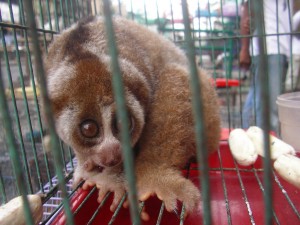Posted on 25/08/2011
YouTube Video Encourages Illegal Pet Trade in Slow Lorises
K.A.I. Nekaris, A.L. Doughty, Oxford Brookes University, School of Social Sciences and Law, Nocturnal Primate Research Group, Oxford OX3 0BP U.K.

In the last year two videos showing the Vulnerable pygmy slow loris (Nycticebus pygmaeus) as a pet have gone viral, receiving together nearly 9 million views. Both videos show the animals in unnatural daylight conditions. The first is of an obese slow loris being tickled, whereas the second shows a highly stressed obese loris with a characteristic head wound desperate to grasp a tiny umbrella. Viewers are also allowed to record whether they ‘like or dislike’ the videos.. Combined, as of late March 2011, the two videos received 3100 likes vs only 1200 dislikes. With more than 9000 comments left on both videos, we were able to categorise them into three major categories: writer endorses pet trade /wants one; writer informs public against having one; writer identifies the species/compares it to film/other. Through analysis of the first 100 comments, we found that for both videos, nearly 60% of comments were from those who wanted one as a pet or were attracted to the idea of having one, whereas only 5-10% informed the viewers of the illegality of keeping lorises as pets.
Policing the content of videos uploaded to YouTube has been a key problem throughout the company’s rapid evolution. YouTube has previously stated that it is not their responsibility to control video content uploaded to their site, however they do take copyright infringement seriously. Other than copyright infringement, content control is maintained through the complaints and notifications from users (Sandoval 2007). YouTube’s terms and conditions state this it is YouTube’s decision to remove any content that has been flagged as illegal. Despite 100’s of comments pointing out the cruelty in the video and the illegality of keeping slow lorises as pets, YouTube has done nothing to remove the offensive videos.
Slow lorises do not breed well in captivity, and most that end up as pets will have been smuggled through the black market from the wild. More often than not, lorises in the trade die due to starvation, dehydration or infection caused through the common practice of removing their teeth with pliers or toe nail clippers, Listed on Appendix 1 of CITES, international trade in slow lorises is prohibited. It is also illegal to buy the offspring of illegally imported parents. Social Networking Sites such as YouTube have become an integrated part of personal identity. We feel that the popularity of these videos could be hazardous to slow loris conservation. Although the video may also bring their plight to millions who had never heard of the animals before, we strongly urge YouTube to remove the videos.
